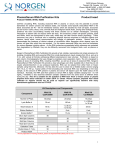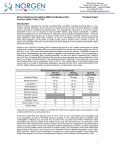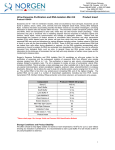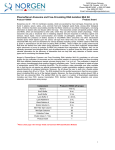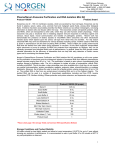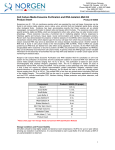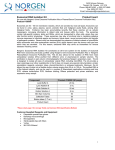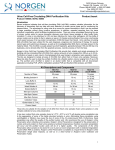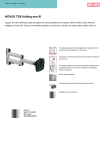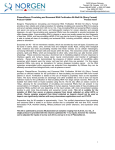Download Protocol - Norgen Biotek Corp.
Transcript
3430 Schmon Parkway Thorold, ON, Canada L2V 4Y6 Phone: 866-667-4362 (905) 227-8848 Fax: (905) 227-1061 Email: [email protected] Urine Cell-Free Circulating and Viral Nucleic Acid Purification Kits Product Insert Product # 59900, 60000, 60100 Introduction Recent evidence indicates that cell-free circulating (cfc) nucleic acids such as DNA and RNA, including exosomal RNA, in urine contains valuable information for the discovery of biomarkers that can help with early detection of certain cancer types, for monitoring the disease status as well as for the detection fetal DNA. Moreover, urine has been widely used for the detection of viral infections, including HIV, HCV and HBV.The advantage for using urine as a source for cancer biomarkers is that it can be acquired in large quantities without using invasive procedures, and repeated sampling from the same individual is applicable, which facilitates longitudinal studies. There are many advantages favouring the use of urinary nucleic acids for cancer biomarker discovery over blood, tissue samples or other bodily fluids, including: (1) urine is noninfectious for HIV and less infectious for many other pathogens; (2) the profile of urinary nucleic acids is similar to that in plasma or serum; (3) nucleic acid purification from urine is technically much easier because of its low protein concentration (1000-fold lower than blood). Exosomes are 40 - 100 nm membrane vesicles, which are secreted by most cell types. Exosomes can be found in saliva, blood, urine, amniotic fluid and malignant ascitic fluids, among other biological fluids. Evidence has been accumulating recently that these vesicles act as cellular messengers, conveying information to distant cells and tissues within the body. The exosomes contain cell-specific proteins, lipids and RNAs, which are transported to other cells, where they can alter function and/or physiology. Recent work has demonstrated the presence of distinct subsets of microRNAs within exosomes which depend upon the tumour cell type from which they are secreted. For this reason exosomal RNAs may serve as biomarkers for various diseases including cancer. Cell-free mitochondrial DNA (cfmtDNA) is also under investigation for its clinical significance. In addition, cell-free fetal DNA has been widely used as a noninvasive method for prenatal diagnosis including early identification of fetal sex, genetic studies for families at high risk for inherited genetic disorders, screening for Rhesus factor, screening for aneuploidy and identification of preeclampsia. Norgen’s Urine Cell-Free Circulating and Viral Nucleic Acid Purification Kits provide a fast, reliable reproducible and simple procedure for isolating total circulating nucleic acids (DNA and RNA) from various urine inputs ranging from 250 µL and up to 30 mL, with various kit formats addressing different urine input volumes. Purification is based on spin column chromatography that uses Norgen’s proprietary resin separation matrix. The kit is designed to isolate all sizes of cfc-DNA and circulating RNA, including microRNA, as well as all sizes of exosomal RNA. Norgen’s Urine Cell-Free Circulating and Viral Nucleic Acid Purification Kits provides a clear advantage over other available kits in that they do not require phenol/chloroform or any protease treatments. Moreover, the kit allows the user to elute into a flexible elution volume ranging from 50 µL to 100 µL. The purified nucleic Acid is of the highest integrity, and can be used in a any downstream applications. Kit Descriptions and Components Number of Preps Mini Kit (Cat.# 59900) 50 preps Midi Kit (Cat.#60000) 20 preps Lysis Buffer A 30 mL 20 mL Maxi Kit (Cat.#60100) 10 preps 1 x 75 mL 1 x 25 mL 20 mL Binding Solution K 25 mL 75 mL Wash Solution A 18 mL 18 mL 18 mL Elution Buffer F 6 mL 6 mL 6 mL Mini Spin Columns 50 20 10 Midi Spin Column 20 Maxi Spin Column 10 Collection Tubes 50 20 10 Elution tubes (1.7 mL) 50 20 10 Product Insert 1 1 1 1 These kits are suitable for the isolation of total nucleic acid (RNA and DNA) from fresh urine samples, frozen urine samples or urine samples collected on any urine preservative. It has been found that urine samples stored at -70°C, -20°C or at 4°C will develop some precipitation due to the aggregation of some of the highly abundant proteins in urine. Eliminating these precipitates using centrifugation or filtration may cause the loss of some of the cfc protein-bound RNA. Furthermore, these precipitates may affect the quality of the purified nucleic acid. We recommend the use of Norgen’s Urine Preservative when collecting urine samples. Norgen’s Urine Preservative is designed for the preservation of nucleic acids and proteins in fresh urine samples at ambient temperatures, therefore no protein precipitation will occur and the purified nucleic acids will be of a higher quality. The components of the Urine Preservative allow samples to be stored for over 2 years at room temperature with no detected degradation of urine DNA, RNA or proteins. Norgen’s Urine Preservative is available as a liquid format in Norgen’s Urine Preservative Single Dose Ampules, as well as in a dried format in Norgen’s Urine Collection and Preservation Tubes Kits Specifications Sample Type Mini Kit Cat.# 59900 Fresh or frozen urine Midi Kit Cat.# 60000 Fresh or frozen urine Maxi Kit Cat.# 60100 Fresh or frozen urine Sample volume Range 250 µL to 2 mL 2 to 10 mL 10 to 30 mL Minimum Elution Volume 50 µL 50 µL 50 µL Maximum Elution Volume 100 µL 100 µL 100 µL Time to Complete 10 Purifications 25 - 30 minutes 40 - 45 minutes 45 - 50 minutes ¥ Size of DNA Purified ≥ 50 bp Size of RNA Purified All sizes, including miRNA and small RNA (<200 nt) Average Yields ¥ Variable depending on specimen Please check page 7 for Average Urine Yields and Common RNA Quantification Methods Customer-Supplied Reagents and Equipments Benchtop microcentrifuge Swinging bucket centrifuges Vortexer Micropipettors 96 – 100% ethanol 100% Isopropanol β - Mercaptoethanol Storage Conditions and Product Stability o All buffers should be kept tightly sealed and stored at room temperature (15-25 C) for up to 2 year without o showing any reduction in performance. It is recommended to warm Lysis Buffer A for 20 minutes at 60 C if any salt precipitation is observed. Quality Control In accordance with Norgen’s Quality Management System, each lot of Norgen’s Urine Cell-Free Circulating and Viral Nucleic Acid Purification Kits are tested against predetermined specifications to ensure consistent product quality. Product Use Limitations Norgen’s Urine Cell-Free Circulating and Viral Nucleic Acid Purification Kits are designed for research purposes only. They are not intended for diagnostic use. Product Warranty and Satisfaction Guarantee NORGEN BIOTEK CORPORATION guarantees the performance of all products in the manner described in our product manual. The customer must determine the suitability of the product for its particular use. 2 Safety Information Ensure that a suitable lab coat, disposable gloves and protective goggles are worn when working with chemicals. For more information, please consult the appropriate Material Safety Data Sheets (MSDSs). These are available as convenient PDF files online at www.norgenbiotek.com. Binding Solution K and Lysis Buffer A contain guanidium salt, and should be handled with care. Guanidium salt forms highly reactive compounds when combined with bleach, thus care must be taken to properly dispose of any of these solutions. If liquid containing these solutions is spilt, clean with suitable laboratory detergent and water. If the spilt liquid contains potentially infectious agents, clean the affected area first with laboratory detergent and water, and then with 1% (v/v) sodium hypochlorite. CAUTION: DO NOT add bleach or acidic solutions directly to the sample-preparation waste. Important Notes Working with RNA RNases are very stable and robust enzymes that degrade RNA. Autoclaving solutions and glassware is not always sufficient to actively remove these enzymes. The first step when preparing to work with RNA is to create an RNase-free environment. The following precautions are recommended as your best defence against these enzymes. The RNA area should be located away from microbiological work stations Clean, disposable gloves should be worn at all times when handling reagents, samples, pipettes, disposable tubes, etc. It is recommended that gloves are changed frequently to avoid contamination There should be designated solutions, tips, tubes, lab coats, pipettes, etc. for RNA only All RNA solutions should be prepared using at least 0.05% DEPC-treated autoclaved water or molecular biology grade nuclease-free water Clean all surfaces with commercially available RNase decontamination solutions When working with purified RNA, ensure that they remain on ice during downstream applications Notes Prior to Use All centrifugation steps are performed at room temperature. Ensure that centrifuge tubes used are capable of withstanding the centrifugal forces required. The provided spin columns are optimized to be used with a benchtop centrifuges and not to be used on a vacuum apparatus Most standard benchtop microcentrifuges will accommodate Norgen's Mini Spin Columns. Most standard swinging bucket centrifuges will accommodate Norgen's Midi and Maxi Spin Columns. Do not use a fixed-angle rotor Norgen's Midi and Maxi Spin Columns are centrifuged in 15 mL and 50 mL centrifuge tubes, respectively. Centrifuging Norgen's Spin columns at a speed higher than recommended may affect RNA yield. Centrifuging Norgen's Spin columns at a speed lower than recommended will not affect RNA yield. However, centrifugation at a lower speed may require longer time for the solutions to pass through the spin column When placing Norgen's Midi and Maxi Spin Columns into the swinging bucket centrifuge make sure that lids of the tubes are not tightly closed. Tightly closed lids may cause back pressure which may cause column clogging or disintegration. Ensure that all solutions are at room temperature prior to use. o It is highly recommended to warm up Lysis Buffer A at 60 C for 20 minutes and mix well until the solutions become clear again if precipitates are present. Prepare a working concentration of the Wash Solution A by adding 42 mL of 96 - 100% ethanol (provided by the user) to the supplied bottle containing 18mL of concentrated Wash Solution A. This will give a final volume of 60 mL. The label on the bottle has a box that may be checked to indicate that the ethanol has been added. The use of β-mercaptoethanol in lysis is highly recommended to isolate RNA for sensitive downstream applications. Add 10 µL of β-mercaptoethanol (provided by the user) to each 1 mL of Lysis Buffer A. If any of the solutions do not go through the Spin Columns within the specified centrifugation time, spin for an additional 1-2 minutes until the solution completely passes through the Column. Do NOT exceed the centrifugation speed as this may affect RNA yield. 3 Preparation of Cell-free Urine Sample 1. 2. 3. Collect and transfer 15-50 mL of urine into a conical tube and centrifuge at 200 x g (~1,000 RPM) for 10 minutes to remove urine exfoliated cells and debris. Decant cell-free urine into new 15-50 mL conical tube. Centrifuge the cell-free urine at 1,800 x g (~3,000 RPM) for 10 minutes to remove any residual debris or bacterial cells. Transfer cell-free urine into a fresh 15-50 mL conical tube. Cell-Free Urine is now ready for the purification of cell-free DNA Please check the product # and proceed to the appropriate section for your Urine cfc-RNA Purification Section 1: Urine Cell-Free Circulating and Viral Nucleic Acid Purification Mini Kit (Cat. #59900) Note: The procedure outlined below is for 2 mL inputs of urine. If processing a sample volume lower than 2 mL urine, simply bring the volume of your samples up to 2 mL using Nuclease-free water and proceed as outlined below. 1. 2. 3. 4. 5. 6. 7. Place 2 mL of cell-free urine in a 15 mL tube (provided by the user). Add 400 µL Binding Solution K and mix well by vortexing for 10 seconds. Transfer 800 µL of the mixture from Step 1 into a Mini Spin column assembled with one of the provided collection tubes. Centrifuge for 2 minutes at 3,300 x g (~7,000 RPM). Discard the flowthrough and reassemble the spin column with its collection tube. Repeat Step 2 two more times to transfer the remaining mixture into the Mini Spin column. Apply 500 µL of Lysis Buffer A to the column and centrifuge for 1 minute at 3,300 x g (~7,000 RPM). Do Not Discard the flowthrough. Reload the flowthrough from Step 4 back to the column and let stand at room temperature for 10 minutes. Centrifuge for 1 minute at 3,300 x g (~7,000 RPM). Do Not Discard the flowthrough. To the flowthrough from Step 5 add 250 µL 100% Isopropanol and mix well by pipetting. Transfer the entire mixture from Step 6 back to the Mini Spin column assembled with one of the provided collection tubes. Centrifuge for 2 minutes at 3,300 x g (~7,000 RPM). Discard the flowthrough and reassemble the spin column with its collection tube. Optional Step: If only RNA is the primary interest, an optional On-Column DNA Removal Protocol is provided in Appendix A for the maximum removal of DNA that may affect sensitive downstream applications. This step should be performed at this point in the protocol 8. Apply 600 µL of Wash Solution A to the column and centrifuge for 1 minute at 3,300 x g (~7,000 RPM). Discard the flowthrough and reassemble the spin column with its collection tube. 9. Repeat Step 8 one more time, for a total of two washes. 10. Spin the column, empty, for 2 minutes at 14,000 x g (~14,000 RPM). Discard the collection tube. 11. Transfer the spin column to a fresh 1.7 mL Elution tube. Apply 50 µL of Elution Buffer F to the column and let stand at room temperature for 2 minutes. Centrifuge for 1 minute at 200 x g (~2,000 RPM), followed by 2 minutes at 5,200 x g (~8,000 RPM). 12. For maximum recovery, transfer the eluted buffer back to the column and let stand at room temperature for 2 minutes. Centrifuge for 1 minute at 400 x g (~2,000 RPM), followed by 2 minutes at 5,800 x g (~8,000 RPM). Urine nucleic acids are ready for the downstream application of your choice. For an explanation of expected yields and recommendations for quantification of the nucleic acids, please refer to Appendix B 4 Section 2: Urine Cell-Free Circulating and Viral Nucleic Acid Purification Midi Kit (Cat. #60000) Note: The procedure outlined below is for 10 mL inputs of urine. If processing a sample volume lower than 10 mL urine, simply bring the volume of your samples up to 10 mL using Nuclease-free water and proceed as outlined below. 1. 2. 3. 4. 5. 6. 7. 8. 9. Place 10 mL of cell-free urine in a 50 mL tube (provided by the user). Add 3 mL Binding Solution K and mix well by vortexing for 10 seconds. Transfer 4.5 mL of the mixture from Step 1 into a Midi Spin column assembled with one of the provided collection tubes. Centrifuge for 3 minutes at 1,000 x g (~2,200 RPM). Discard the flowthrough and reassemble the spin column with its collection tube. Repeat Step 2 two more times to transfer the remaining mixture into the Midi Spin column. Apply 400 µL of Lysis Buffer A to the column and centrifuge for 3 minutes at 500 x g (~1,600 RPM). Do Not Discard the flowthrough. Apply an additional 400 µL of Lysis Buffer A to the column and centrifuge for 3 minutes at 500 x g (~1,600 RPM). Do Not Discard the flowthrough. Reload the 800 µL flowthrough from Step 5 back to the column and let stand at room temperature for 20 minutes. Centrifuge for 3 minutes at 1,000 x g (~2,200 RPM). Do Not Discard the flowthrough. To the flowthrough from Step 6 add 400 µL 100% Isopropanol and mix well by pipetting. Transfer 600 µL of the mixture from Step 7 to a Mini Spin column assembled with one of the provided collection tubes. Centrifuge for 2 minutes at 3,300 x g (~7,000 RPM). Discard the flowthrough and reassemble the spin column with its collection tube. Repeat Step 8 one more time to transfer the remaining mixture into the Mini Spin column. Optional Step: If only RNA is the primary interest, an optional On-Column DNA Removal Protocol is provided in Appendix A for the maximum removal of DNA that may affect sensitive downstream applications. This step should be performed at this point in the protocol 10. Apply 600 µL of Wash Solution A to the column and centrifuge for 1 minute at 3,300 x g (~7,000 RPM). Discard the flowthrough and reassemble the spin column with its collection tube. 11. Repeat Step 10 one more time, for a total of two washes. 12. Spin the column, empty, for 2 minutes at 14,000 x g (~14,000 RPM). Discard the collection tube. 13. Transfer the spin column to a fresh 1.7 mL Elution tube. Apply 50 µL of Elution Buffer F to the column and let stand at room temperature for 2 minutes. Centrifuge for 1 minute at 200 x g (~2,000 RPM), followed by 2 minutes at 5,200 x g (~8,000 RPM). 14. For maximum recovery, transfer the eluted buffer back to the column and let stand at room temperature for 2 minutes. Centrifuge for 1 minute at 400 x g (~2,000 RPM), followed by 2 minutes at 5,800 x g (~8,000 RPM). Urine nucleic acid is ready for the downstream application of your choice. For an explanation of expected yields and recommendations for quantification of the nucleic acid, please refer to Appendix B Section 3: Urine Cell-Free Circulating and Viral Nucleic Acid Purification Maxi Kit (Cat. #60100) Note: The procedure outlined below is for 30 mL inputs of urine. If processing a sample volume lower than 30 mL urine, simply bring the volume of your samples up to 30 mL using Nuclease-free water and proceed as outlined below. 1. 2. 3. Place 30 mL of cell-free urine in a 50 mL tube (provided by the user). Add 9 mL Binding Solution K and mix well by vortexing for 10 seconds. Transfer 13 mL of the mixture from Step 1 into a Maxi Spin column assembled with one of the provided collection tubes. Centrifuge for 3 minutes at 1,000 x g (~2,200 RPM). Discard the flowthrough and reassemble the spin column with its collection tube. Repeat Step 2 two more times to transfer the remaining mixture into the Maxi Spin column. 5 4. 5. 6. 7. 8. 9. Apply 600 µL of Lysis Buffer A to the column and centrifuge for 3 minutes at 500 x g (~1,600 RPM). Do Not Discard the flowthrough. Apply an additional 600 µL of Lysis Buffer A to the column and centrifuge for 3 minutes at 500 x g (~1,600 RPM). Do Not Discard the flowthrough. Reload the 1.2 mL flowthrough from Step 5 back to the column and let stand at room temperature for 30 minutes. Centrifuge for 3 minutes at 1,000 x g (~2,200 RPM). Do Not Discard the flowthrough. To the flowthrough from Step 6 add 600 µL 100% Isopropanol and mix well by pipetting. Transfer 600 µL of the mixture from Step 7 to a Mini Spin column assembled with one of the provided collection tubes. Centrifuge for 2 minutes at 3,300 x g (~7,000 RPM). Discard the flowthrough and reassemble the spin column with its collection tube. Repeat Step 8 two more time to transfer the remaining mixture into the Mini Spin column. Optional Step: If only RNA is the primary interest, an optional On-Column DNA Removal Protocol is provided in Appendix A for the maximum removal of DNA that may affect sensitive downstream applications. This step should be performed at this point in the protocol 10. Apply 600 µL of Wash Solution A to the column and centrifuge for 1 minute at 3,300 x g (~7,000 RPM). Discard the flowthrough and reassemble the spin column with its collection tube. 11. Repeat Step 10 one more time, for a total of two washes. 12. Spin the column, empty, for 2 minutes at 14,000 x g (~14,000 RPM). Discard the collection tube. 13. Transfer the spin column to a fresh 1.7 mL Elution tube. Apply 50 µL of Elution Buffer F to the column and let stand at room temperature for 2 minutes. Centrifuge for 1 minute at 200 x g (~2,000 RPM), followed by 2 minutes at 5,200 x g (~8,000 RPM). 14. For maximum recovery, transfer the eluted buffer back to the column and let stand at room temperature for 2 minutes. Centrifuge for 1 minute at 400 x g (~2,000 RPM), followed by 2 minutes at 5,800 x g (~8,000 RPM). Urine nucleic acid is ready for the downstream application of your choice. For an explanation of expected yields and recommendations for quantification of the nucleic acid, please refer to Appendix B Appendix A Protocol for Optional On-Column DNA Removal Norgen’s Urine Cell-Free Circulating and Viral Nucleic Acid Purification Kits isolate total nucleic acid (RNA and DNA) in one elution. However, an optional protocol is provided below for the maximum removal of DNA that may affect sensitive downstream applications if your primary interest is cell-free circulating RNA. It is recommended that Norgen’s RNase-Free DNase I Kit (Product # 25710) be used for this step. 1. For every on-column reaction to be performed, prepare a mix of 15 µL of DNase I and 100 µL of Enzyme Incubation Buffer using Norgen’s RNase-Free DNase I Kit (Product # 25710). Mix gently by inverting the tube a few times. DO NOT VORTEX. Note: If using an alternative DNase I, prepare a working stock of 0.25 Kunitz unit/µL RNase-free DNase I solution according to the manufacturer’s instructions. A 100 L aliquot is required for each column to be treated. 2. Perform the procedure up to Step 7 (Mini Format) or up to Step 9 (Midi and Maxi Format). 3. Apply 400 µL of Wash Solution A to the column and centrifuge for 30 seconds at 6,000 RPM. Discard the flowthrough and reassemble the spin column with its collection tube. 4. Apply 50 µL of the RNase-free DNase I solution prepared in Step 1 to the column and centrifuge at 8,000 x g (~10,000 RPM) for 1 minute. Note: Ensure that the entire DNase I solution passes through the column. If needed, spin at 13,000 x g (~14,000 RPM) for an additional minute. 5. After the centrifugation in Step 4, pipette the flowthrough that is present in the collection tube back onto the top of the column. Note: Ensure Step 5 is performed in order to ensure maximum DNase activity and to obtain maximum yields of RNA, in particular for small RNA species. o 6. Incubate the column assembly at 25 - 30 C for 15 minutes. 7. Without any further centrifugation, proceed directly to the second wash step in Step 9 (Mini Format) or to the second wash step in Step 11 (Midi and Maxi Format). 6 Appendix B Cell-Free Circulating Nucleic Acid Yield Urine total Nucleic Acid, like RNA and DNA in other cell-free bodily fluids, is normally found in very low amounts (1 - 100 pg/µL), therefore measuring cell-free RNA or DNA concentration using common quantification methods is very difficult and challenging. Typical yields of urine Nucleic Acid vary significantly from sample to sample. Variability is also observed between samples collected from the same donor at different times during the day and therefore there is no absolute yield for RNA purified from bodily fluids including urine. Cell-free circulating RNA yield varies depending on a number of factors including age, sex, diet, exercise and most importantly the health status of the donor. Below is a list of the most common RNA and DNA quantification methods, as well as the limit of detection for each of these methods. Unfortunately, none of these methods can be used reliably for measuring the concentration of the purified nucleic acid from urine unless large urine volumes have been processed. This would only be applicable if urine contains the maximum amount of nucleic acid that can fit within the specification range of these quantification tools. It should be noted that the specifications outlined below are based on measuring a pure RNA/DNA, which will not be the case for the nucleic acid purified from urine. Urine nucleic acid is short and fragmented, and is usually present in less than 1000 bp. Purified urine nucleic acid usually contains traces of proteins which will interfere with most quantification methods, leading to the overestimation of the purified nucleic acid concentration. Therefore purified nucleic acid contaminated with more proteins will be presented at a higher concentration as compared to nucleic acid purified with less protein contaminants, which in this case will depend on the method used for urine nucleic acid purification. The only reliable method that can assess the quality and the relative quantity of the purified urine nucleic acid is RT-qPCR (RNA) or qPCR (DNA) amplification of a standard RNA or DNA using a small amplicon such as the 5S rRNA housekeeping gene. Common Nucleic Acid Quantification Methods 1) Bioanalyzer RNA Quantification Kits RNA 6000 Nano Kit RNA 6000 Pico Kit Small RNA kit Total RNA mRNA Total RNA mRNA Total RNA Quantitative range 25 - 500 ng/µL 25 - 250 ng/µL 5 - 500 ng/µL 5 - 250 ng/µL ---250 - 5000 pg/µL 50-2000 pg/µL Qualititative range ---50 - 5000 pg/µL Quantitation accuracy 20% CV 20% CV 30% CV ---- ------ 50-2000 pg/µL 2) Bioanalyzer DNA Quantification Kits Size Range DNA 1000 Kit 25–1000 bp DNA 7500 Kit 100–7500 bp DNA 12000 Kit 100–12000 bp High Sensitivity DNA Kit 50-7000 bp Quantitation accuracy 20% CV* 20% CV* 25% CV* 20% CV Quantitative range 0.5-50 ng/µL 0.5-50 ng/µL 0.5-50 ng/µL 5-500 pg/µL 3) NanoDrop 2000 Detection Limit: 2 ng/µl (dsDNA) 4) Quant-iT™ RiboGreen® RNA Assay Kit Quantitation Range: 1-200 ng 5) Quant-iT™ Pico Green® dsDNA Assay Kit Detection Limit: 25 pg/mL 6) qPCR Standard Curve (generated using Norgen’s Low Abundance DNA Quantification Kit, Cat# 57200) 7 30 pg 30 fg 300 fg 3 pg 100 pg 300 pg 10 pg Frequently Asked Questions 1. What If a variable speed centrifuge is not available? A fixed speed centrifuge can be used, however reduced yields may be observed. 2. At what temperature should I centrifuge my samples? All centrifugation steps are performed at room temperature. Centrifugation at 4C will not adversely affect kit performance. 3. What if I added more or less of the specified reagents’ volume? Adding more or less than the specified volumes may reduce both the quality and the quantity of the purified nucleic acids. Eluting your nucleic acids in high volumes will increase the yield but will lower the concentration. Eluting in small volumes will increase the concentration but will lower the overall yield. 4. What If I forgot to do a dry spin before my final elution step? Your purified nucleic acids will be contaminated with the Wash Solution A. This may reduce the quality of your purified nucleic acid and will interfere with your downstream applications. 5. Can I perform a second elution? nd st Yes, but it is recommended that the 2 elution be in a smaller volume (50% of 1 Elution). It is also nd st recommended to perform the 2 elution into a separate elution tube to avoid diluting the 1 elution. 6. Why do my samples show low nucleic acid yield? Urine samples contain very little nucleic acid. This varies from individual to individual based on numerous variables. In order to increase the yield, the amount of urine input could be increased. 7. Why do the A260:280 ratio of the purified nucleic acid is lower than 2.0? Most of the Free-Circulating urine nucleic acid is short nucleic acid fragments. The A260:280 ratio is normally between 1 – 1.6. This low A260:280 ratio will not affect any downstream application. 8. Why does my isolated RNA not perform well in downstream applications? If a different Elution Buffer was used other than the one provided in the kit, the buffer should be checked for any components that may interfere with the application. Common components that are known to interfere are high salts (including EDTA), detergents and other denaturants. Check the compatibility of your elution buffer with the intended use. 9. Do I need to do a DNase treatment for my nucleic acid Elution? You may need to do a DNase treatment to your isolated urine miRNA. It is recommended to use Norgen’s RNase-Free DNase I Kit (Cat# 25710). Also please refer to the protocol for optional oncolumn DNA removal outlined in Page 6. 8 Technical Assistance NORGEN’s Technical Service Department is staffed by experienced scientists with extensive practical and theoretical expertise in sample and assay technologies and the use of NORGEN products. If you have any questions or experience any difficulties regarding Norgen’s Urine Cell-Free Circulating and Viral Nucleic Acid Purification Kits or NORGEN products in general, please do not hesitate to contact us. NORGEN customers are a valuable source of information regarding advanced or specialized uses of our products. This information is helpful to other scientists as well as to the researchers at NORGEN. We therefore encourage you to contact us if you have any suggestions about product performance or new applications and techniques. For technical assistance and more information, please contact our Technical Support Team between the hours of 8:30 and 5:30 (Eastern Standard Time) at (905) 227-8848 or Toll Free at 1-866-667-4362. or call one of the NORGEN local distributors (www.norgenbiotek.com) or through email at [email protected]. 3430 Schmon Parkway, Thorold, ON Canada L2V 4Y6 Phone: (905) 227-8848 Fax: (905) 227-1061 Toll Free in North America: 1-866-667-4362 ©2015 Norgen Biotek Corp. PI59900-1 9











